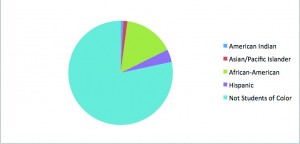 The level of student diversity at Bowling Green State University is rising.
The level of student diversity at Bowling Green State University is rising.
During the past three years, the percent of new students of color enrolled in the fall has risen from 17.2 percent in 2009, to 20.7 percent in 2010 and to 22 percent in 2011, according to the office of admissions Fall 2011 New Student Summary.
The rise hasn’t happened without university involvement; the university has been working toward the goal of a more diverse student body for several years.
“As long as I’ve been here, the goal always seems to be more,” said Gary Swegan, director of admissions, who has worked at the university for 23 years.
The university wants to improve the level of diversity to help students, Swegan said.
“It’s so students have the opportunity to learn in an environment that is reflective of the environment when you get out,” Swegan said.
Fahad Aoruweili, an international student, said he has noticed an increased level of diversity.
“I can see a lot of colors here, there are people from everywhere,” Aoruweili said.
Aoruweili doesn’t think the diversity at the university is representative of the diversity in the outside world, he said every place should be as diverse at the university.
The university continues to strive for more diversity and in order to achieve the goal, the university has a “diversity initiative” and several staff members who work to better the level of diversity. In addition, BGSU offers many programs to encourage diverse students to attend, educate students about diversity and make more diverse students feel at home, said Emily Monago, director of the Office of Multicultural Affairs.
The BGSU Office of Admissions is the first step for prospective students of all races and ethnicities. These two aspects of diversity are tracked: race and ethnicity, said Swegan. Included in the admissions staff of 40 are four staff members who work specifically to recruit “students of color,” Swegan said.
“Students of color” refers to the following ethnicities: American Indian, Asian/Pacific Islander, African American and Hispanic, according to admissions’ Fall 2011 New Student Summary.
Recruiting includes coordinating programs such as traveling to urban areas to recruit minority students, hosting programs and going to college fairs, Swegan said.
Multicultural information sessions and overnight visits are offered to minority students when they visit the university.
“We try to highlight those areas that are of greatest interest to those students,” Swegan said.
Admitted students who choose to visit overnight are hosted by minority student recruitment team members, Swegan said.
The university doesn’t only strive to recruit minority students, but to retain them as well, Swegan said.
Students who attend the university have the opportunity to enroll in classes about multicultural issues.
The multicultural development program course, offered by the Office of Multicultural Affairs, focuses on helping diverse students be successful academically, Monago said.
The course may also help students who haven’t been exposed to diversity.
“Their community may not see types of representation and diversity at the university,” Monago said. “The class can help them develop cultural competency skills.”
These “competency skills” can help students become familiar with the level of diversity at BGSU, Monago said.
“I think our university is definitely moving in the right direction,” Monago said.
Despite the facts, university senior Cori Mesenbring hasn’t noticed a change in diversity during her time at the university.
“I think it has stayed pretty much the same,” Mesenbring said.
The level of diversity at other Ohio universities varies. At Ohio University, the new students of color enrolled in the fall semester in 2010 was 9.7 percent of total first year students, according to the university’s website.
At Ohio State University, the new students of color enrolled in the fall semester in 2011 was 17.6 percent of total first year students, according to the university’s website.
While the level of diversity at universities is important, it doesn’t solve every problem, said Donna Kauffman, lecturer in the sociology department at BGSU.
“There seems to be this general assumption that if we have a diverse population we’ve solved all of our problems,” Kauffman said. “We’ve never really dealt with the deeper issues.”
A deeper issue like the fact that Americans are raised in a racist society, the racist thinking doesn’t go away just because diverse people are put together, Kauffman said.
Mesenbring thinks that diversity can begin to solve racism.
“I definitely think it would help eliminate ignorance,” Mesenbring said. “Once you get to know people from different parts of the world and different backgrounds, it’s easier to understand why people are different from you.”
Research indicates that everybody benefits from being exposed to people that are different, Kauffman said, but the benefits of diversity are only individual.
Diversity is a good first step, but there needs to be follow up in the form of a safe environment where issues of race and racism can be discussed and challenged, she said.
“I don’t think we create this environment,” Kauffman said. “We just throw people together and assume the problems will solve themselves and they don’t.”
The university is the one place this kind of environment could be possible, Kauffman said, but only if the university creates it.
test Filed under Uncategorized | Comment (0)